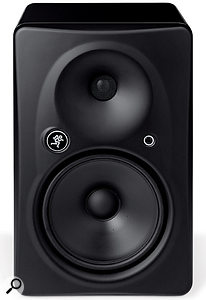I don't hear a lot said about passive radiator speaker technology. What are pros and cons of that design? Technically, it's still a sealed-box design and should have some benefits over a ported design, right?Via SOS web site

SOS Technical Editor Hugh Robjohns replies: A passive radiator speaker is a sealed box insofar as you couldn't easily pour a pint of beer into the thing (should the madness take you), but as far as the air movement is concerned it isn't really sealed at all, because the internal air-pressure changes are still relieved by the passive radiator moving in and out.The Mackie HR 824 MkII is one of the the few compact studio monitors that currently uses a passive radiator, located on the rear panel behind the amplifier chassis.The Mackie HR 824 MkII is one of the the few compact studio monitors that currently uses a passive radiator, located on the rear panel behind the amplifier chassis.
What the passive radiator does, basically, is create a larger port area, without the airflow noises that might otherwise occur, and help control the frequency range over which the port is effective. More swings and roundabouts, really, but it definitely falls into the vented box camp, and doesn't have any of the positive time-domain benefits of the sealed-box team.
No comments:
Post a Comment